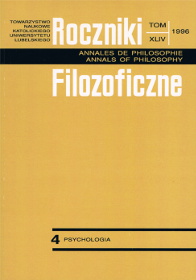The Level of Intelligence and Self-concept in Paranoid Schizophrenics
Abstract
180 patients with paranoid schizophrenia were subject to examination. They were examined individually, in the period of remission. Their intellectual capacities were assessed by means of the Wechsler-Bellvue Scale, whereas self-concept was assessed by the Adjective Check List. On the basis of a general intelligence quotient the following extreme subgroups were statistically isolated:
− with the lowest intelligence quotient in the group under examination (85-101; x = 92,9), which comprised 46 subjects;
− with the highest intelligence quotient in the group under examination (116-132; x = 120,6), which comprised 47 subjects.
In the subsequent stage the real and retrospective self-concepts were compared with the highest and lowest intelligence quotients, thereby the following conclusions could be drawn:
1. The real self-concepts in paranoid schizophrenics differ essentially in relation to their level of intelligence.
2. The patients with the highest and lowest intelligence quotient have similar retrospective self-concepts.
3. The patients with higher intelligence quotient have a more intense sense of changing oneself than the patients with a lower quotient.
References
Chlewińsk i Z., Grzywa A.: Urojeniowa wizja świata. Warszawa 1992. Wiedza Powszechna.
Chuchra M.: Realny obraz siebie chorych na schizofrenię paranoidalną w zależności od płci i poziomu lęku. Pamiętnik IV Lubelskich Spotkań Naukowych. Lublin 1995 s.154−160.
Chuchra M.: Obraz siebie w przebiegu schizofrenii paranoidalnej. (Praca doktorska − mps. Biblioteka AM w Lublinie). Lublin 1996.
Conrad K.: Die Beginnende Schizophrenie. Versuch einer Gestaltsanalyse des Wahns. Stuttgart 1958. Georg Thieme Verlag.
Epstein S.: Unconscious Self−evaluation in a Normal and a Schizophrenic Group. Reprinted from „The Journal of Abnormal and Social Psychology” 1955 nr 1 s.50.
Fitts W. H.: The Self Concept and Psychopatology. Dede Wallace Center Monograph Nashville. Tennessee 1972.
Grzywa A.: Geneza, struktura i dynamika urojeń w schizofrenicznych zespołach paranoidalnych. Rozprawa habilitacyjna. Lublin 1991.
Havener P. H.: Unrealistic Self−enhancement in Paranoid Schizophrenics. „Journal of Consulting Psychology” 26:1962 nr 1 s.65−68.
Jucha Z.: Deficyt intelektualny w schizofrenii. „Roczniki Filozoficzne” 21:1973 z.4 s.75−101.
Juros A., Oleś P.: Struktura czynnikowa i skupieniowa Testu Przymiotnikowego ACL H. G. Gougha i A. B. Heilbruna. W: J. Brzeziński, E. Hornowska (red.). Z psychometrycznych problemów diagnostyki psychologicznej. Poznań 1993 s.171−201. Wydawnictwo Naukowe Uniwersytetu im. A. Mickiewicza.
Makselon J.: Obraz siebie. „Ateneum Kapłańskie” 73:1981 t. 96 z. 2 s. 307−312.
Markova I. S., Berrios G. E.: The Meaning of Insight in Clinical Psychiatry. „British Journal of Psychiatry” 1992 nr 160 s. 850−860.
Mojdehi H.: Change and Stability of Self−concepts of Iranian Psychiatric Patients and Normals. „Psychological Reports” 1978 nr 35 s.384−391.
Patterson B.: Discrepancies Between Self−concepts and Ideal Self−concepts in Paranoid Schizophrenics and Normal. „Journal of Clinical Psychology” 16:1960 nr 3 s.297−302.
Płużek Z.: An Investigation on the Influence of Rehabilitation Upon Chronic Schizophrenies. Final Report VRA − POL − 5 − 65. Warszawa 1975.
Quekelberghe R.: Untersuchung zum Selbstkonzept von chronisch Schizophrenen und zum Bild des Geisteskranken. „Psychologische Rundschau” 1976 nr 27 s.28−39.
Robson P. J.: Self−esteem − a psychiatric view. „British Journal of Psychiatry” 1988 nr153 s.6−15.
Weckowicz T. E., Sommer R.: Body Image and Self−concept in Schizophrenia. „The Journal of Mental Science” 1960 nr 106 s.17−39.
Copyright (c) 1996 Roczniki Filozoficzne

This work is licensed under a Creative Commons Attribution-NonCommercial-NoDerivatives 4.0 International License.





